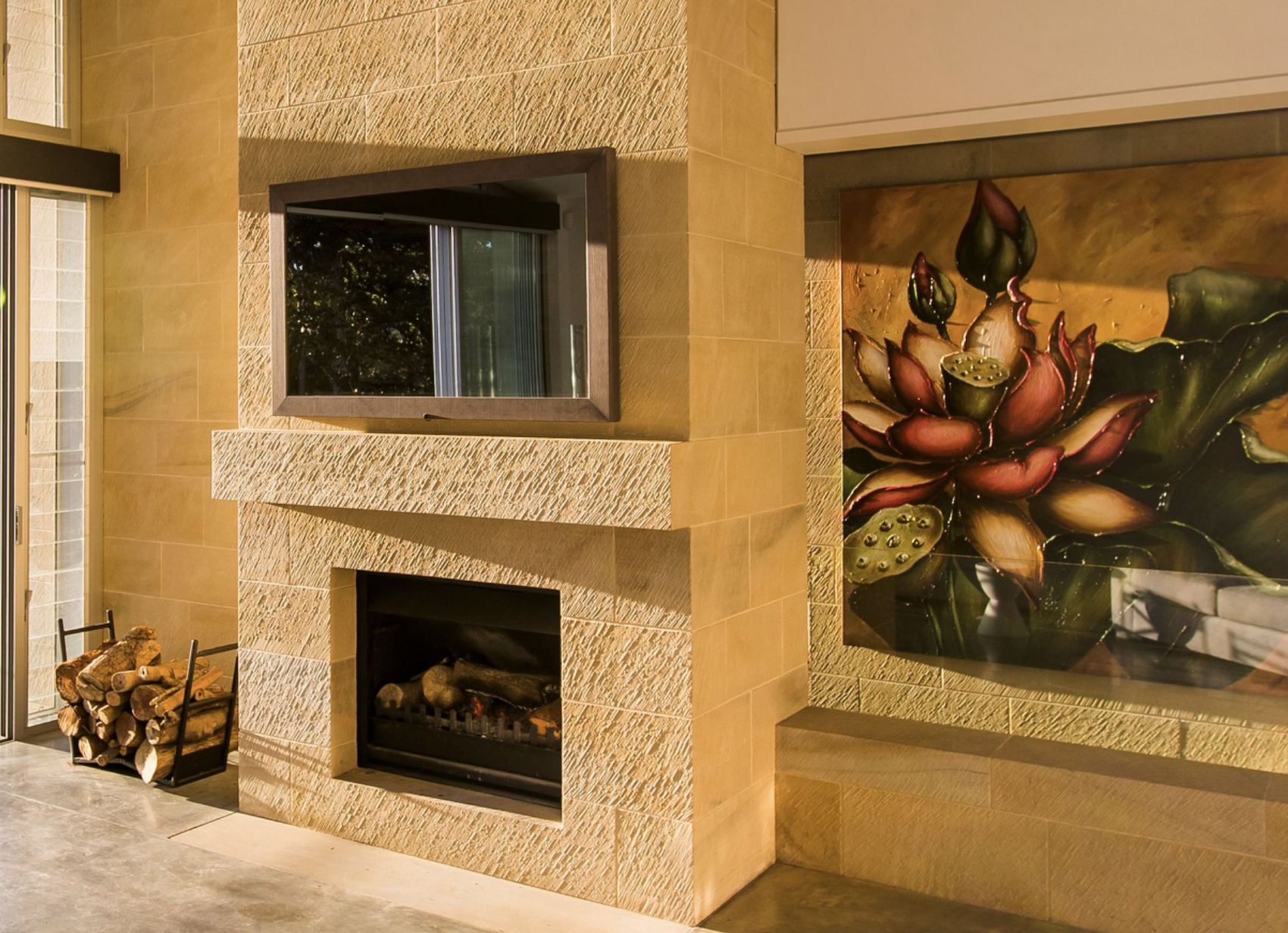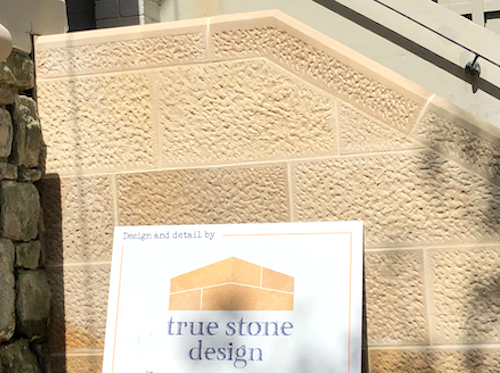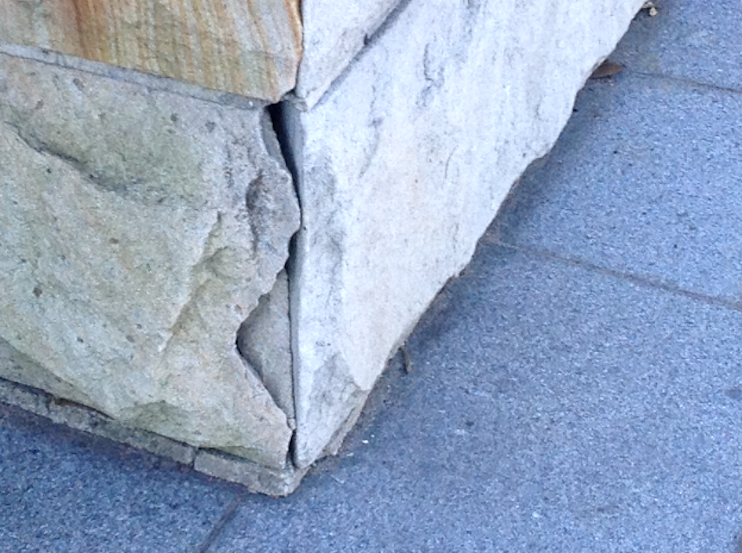Is The Beauty of Stone More Than Skin Deep?
Damian Cudmore, August 2018
There exists a wide variety of stone styles, standards and processes currently being expressed in the residential house sector at all levels.
This report will discuss two different, and largely separate, categories within Exterior Design culture:
- Stone as a Finish Element
- Stone as a Structural Expression
Examples of each may look similar to the other, on the surface. They are both, after all, comprised of stone.
But they each differ markedly in at least 3 aspects:
- Architectural Effect
- Craft Process
- Perceived Cost, and
- Personal Architectural Belief
To shine a light towards an informed choice between the two, following is an exploration of the features, and philosophies of each stone model. Each approach is dependant upon a belief.
Architectural Belief
Everyone, including the non-architectural lay person, holds beliefs about their world, including the ‘built’ world, and their experience of the space within and around it.
This analysis attempts to expand the choice spectrum beyond stone products and details, towards an understanding of personal architectural belief.
Stone As Finish
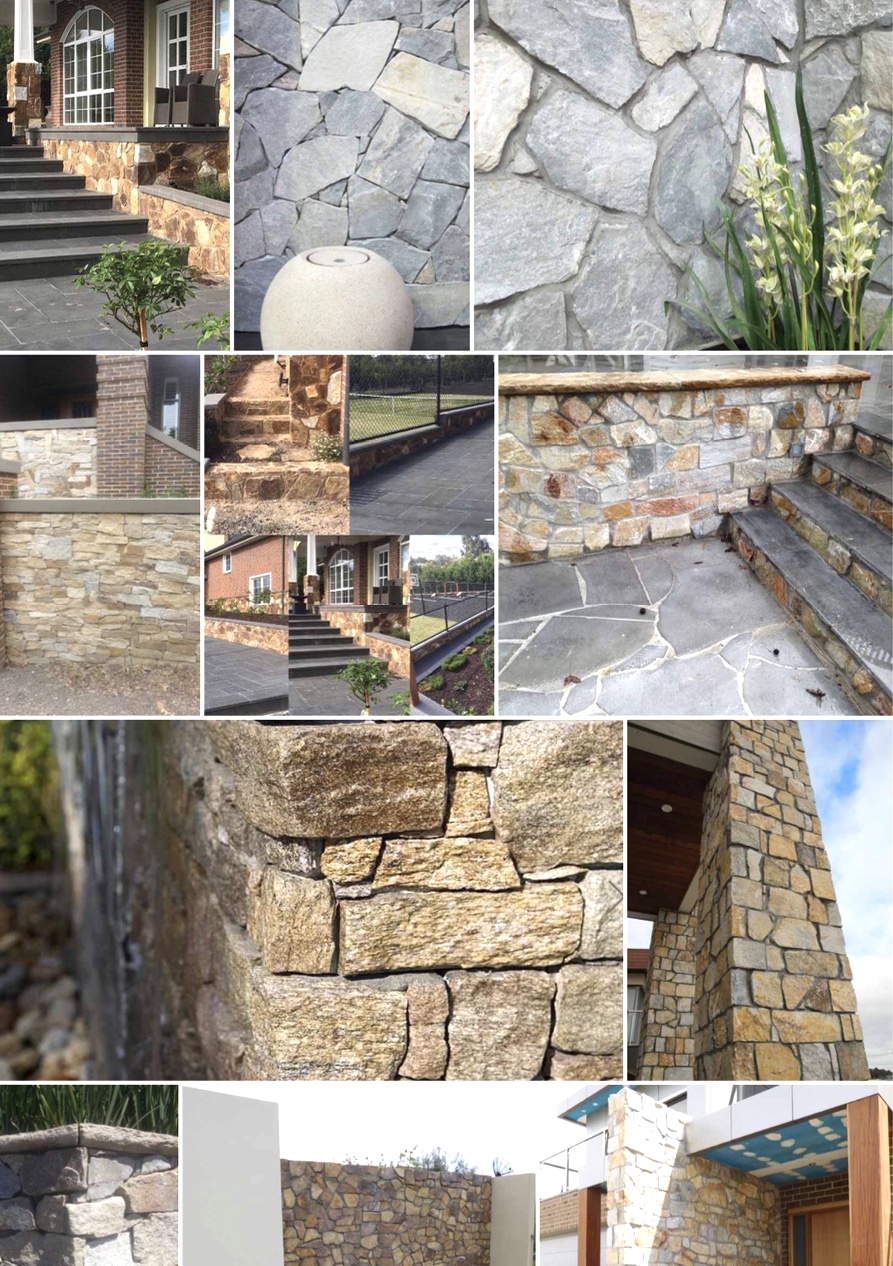
Analysis of architectural stone choices over the last twenty years has seen an increase in the trend of owners and architects adopting a ‘stone as finish’ model.
The ‘stone as finish’ point of view sees stone essentially as a Two-Dimensional product, utilised to ‘decorate’ a hidden and pre-existing structure with small factory-produced, and – thinly-sliced pieces.
And within this model a world of choice has exploded.
Where once we crafted and built with chunks of stone quarried on site or in nearby fields, today we may finish our wall surfaces, floors and terraces with stones of a wide variety from all corners of the globe.
We are awash with choice in surface finish.
And domestic (as well as commercial) buildings display a wide variety of stone classes, types, colours, tones and textures.
Contextual Catalysts for the ‘Stone as Finish’ Model
The popular trend towards the Stone as Finish Model may have been created as much by contextual catalysts as by pure architectural intention.
A number of converging contextual factors may have contributed to the widespread popularity of the Stone Finish/Hidden Structure culture. They are:
1. The ‘Surface Finish/Hidden Structure’ Delineation
Within current construction culture there is a belief in a necessary Separation between Structure and Finish.
The culture assumes that first a structure is built, usually in concrete or masonry, then the ‘finishes’ are added, externally and internally
The underlying assumption in the Finish model envisages stone primarily as an expressive ‘Finish’ retrofitted to a pre-existing structure.
And the Geometric Result here often is a Two Dimensional finish to surface ‘areas’.
2. Globalised Supply Market
Serving the ‘stone as finish’ culture is a ‘market’ awash with options.
From Italy to Turkey to China we have now tonnes of tones and hues awaiting our gaze in showrooms all over the country.
3. Designers standing on the shoulders of Decorators?
The Stone as Finish model has origins way back in time. The Romans created ‘veneer’ finishes for their structures though these were far different from the wafer thin tile dimensions presently in contemporary projects. The wafer surface culture may be born of two modern developments:
- CAD programs that separate materials and finishes at the design phase, which may then
propel an ‘wafer’ assumption into the construction phase, and - A relatively recent Interior Designer Sector, a development from a previous Painter and Decorator culture, highly competent in colour tone and texture – in 2 dimensions and on interior surfaces.
The TCTT (Type Colour Tone Texture) priority in Interior stone design (see glossary of terms) has moved from bathrooms and kitchens to the lounge room, and then to the verandahs, and now the outdoor proper, including building facades
4. Finish Model Language
The language of this model talks about areas of coverage, or finish.
That is, the greatest amount of Wall or floor should be covered (finished) as beautifully, but also as thinly and as efficiently as possible.
This model also tends to speak of ‘products’, rather than ‘details’.
5. Perceived Economy
One key factor driving the popularity of this ‘finish’ trend may not be aesthetic though.
By slicing stone thinner and fixing the resulting dimensions on our walls and horizontal surfaces, we are also stepping into more accessible budget brackets.
The lighter weight of individual pieces means that they may be installed quickly at a much lower cost than traditional solid Stonemasonry. Tilers can lay many more square metres of tiles than a traditional stonemason can build a solid wall.
A Turkish limestone delivered to Sydney in 30mm thicknesses can be bought and installed by a tiler at the fraction of the cost of 3-Dimensional local stone.
So, a perceived budget advantage may be also be an impetus of the Finish Model as well as a result.
Stone as Finish – in Summary
In summary the contexts of the Finish ‘explosion’ are multiple.
– The rise of ‘construction phasing’ and the separate structure phase separate from the finish phase in building culture. There has been sound, practical reasons for this development. Site process simplicity being one of them.
– The opportunity and Diversity (See Glossary of Terms below) offered by a globalised supply market .
– A general ‘re-skilling’ (and sometimes de-skilling) of the on-site stone labour force, and a movement of the locus of craft effort from site to factory
– The push to ‘economise’ stone by slicing it up into decreased wafer dimensions.
– The preoccupations of the Supplier market here are similar to those in Interior Design with its its emphasis on the preoccupations of painting and decorating, namely:
- Colour
- Tone
- Texture
- A compulsion to simplify site safety by making building elements smaller, and processes more ergonomic.
The Aesthetic Outcome of the Stone as Finish Model
The cultural result of the Stone Finish industry is an unprecedented array of surface colour, tone and texture choices available to architects and designers, professional and otherwise.
The palette is awash with options.
Further there is an accelerated accessibility to these products.
They are offered in ever thinner dimensions, for ever lower prices per square metre.
This trend remains strong and has been so for 10-20 years.
Some believe that we have entered into a ‘stone choice paradise’, and have proceeded to specify, purchase and build with a vast variety of stone finishes.
Stones finishes are chosen with almost as much freedom as choices in render and paint.
Many assume, and will even argue, that because stone is a finish, then ‘Finishing’ is its only role. However, is everyone convinced?
Challenges for the ‘Stone as Finish’ Model
1. A Practical Matter – Tensile Stress
The Finish Model utilises decreased thicknesses and occasional ‘feathers’ to achieve its architectural intentions. Feathering examples include Mitred Corners, Birds Mouth Details, Copings mitred in Plan and Elevation.
There is a strong argument about the use of stone mitres at all, due to the mitre’s reliance on tensile material strength. (See Strength in GOT below)
In short, stone, especially sedimentary stone like sandstone, is not well suited to applications that test tensile strength, such as external traffic areas likely to endure occasional impact.
The use of mitres in the crafting of laminated corner details in marble and granite interiors is less vulnerable than such use in external sandstone.
To be fair, many Stone Finish Suppliers offer Quoin products as an alternative to the Mitre Detail. However the practice of Mitred details in external contexts is still widespread.
‘Never take a material through to infinity’
Jørn Utzon, with reference to a crafted mitre, 1965.
A risk faced by feathered mitres.
2. An Architectural Question
Another aspect of the Finish Culture is extreme ‘simplification’.
The language of supply sales largely eschews structurally expressive elements.
Although many finish Suppliers now offer ‘Quoin options). structurally expressive Lintels, Copings and Stair Treads are rare.
Structural Expression seems to be widely seen as an irrelevance to the finish market.
3. Prevailing ‘Language’ of Stone
A google search of ‘stone wall products’ with deliver, in the image bar, dozens of images of wildly divergent stone types and styles, divergent except for one aspect- the third dimension. The conversation is concentrated on Type, Colour, Tone and Texture.
If there is an alternate approach to stone detailing, what might it be?
Stone as an Element of Structural Expression
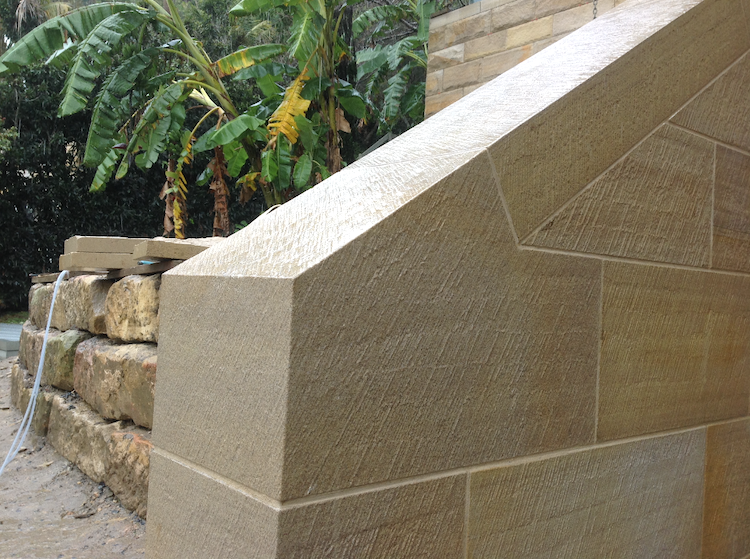
Structure is one of stone’s historical functions, especially in the days before concrete and brick.
A current model of Structural Expression in stone draws belief, direction, and even inspiration, from the precedents found in traditional stone craft.
Structural Expression occurs when an individual element, (or group of elements) making up a coordinated detail, express a sense that it is, at least, ‘holding itself up’.
Structure is most expressed when the element also supports other stone and non-stone elements.
Although structural expression draws precedent (and a significant skill-base) from historical traditions, it does not need to be confined to classical detail styles.
Modern minimalist forms may imaginatively accomodate structural expression in brief and craft execution.
The most obvious feature of structural expression is ‘solidity’, the inclusion of the Third Dimension (thickness) in element proportion.
But other structurally expressive features include:
- Generous Bond (overlap) between courses,
- Joint Arrangement (eg radiating joints in an arch)
- Interface details -where non structural elements ‘give way’ to structurally expressive ones.
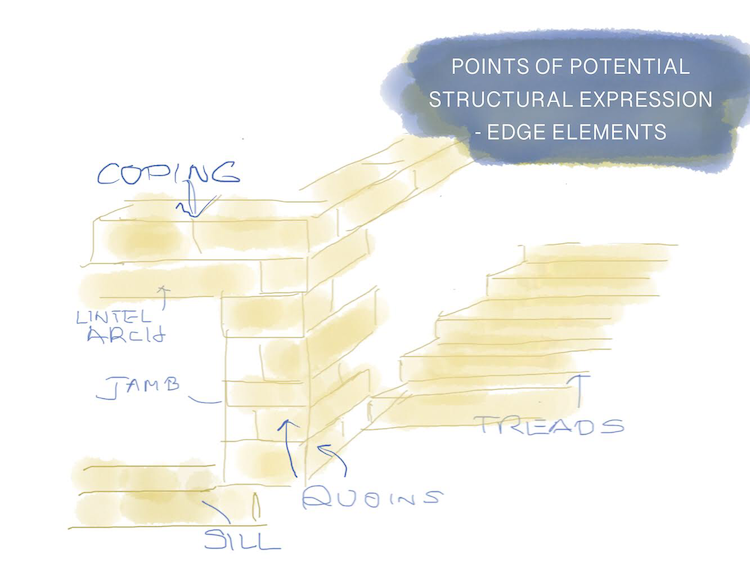
Structural Expression requires that detail attention be given to:
- Three Dimensional elements (notably thickness)
- Dimensional Dexterity (that is a system of Customising Sizes and Shapes) – especially with regard to classically dimensioned Quoins, Copings, Jambs, Lintels, Sills and Treads
- Gauging -joints require generous bond (overlap) to maintain structural integrity. Even if hiddenvfixings are structurally sufficient, expressed bonds afford a visual sense of structure
- Proportion. Short quoins and Ultra thin Copings dilute structural expression.
- Interface with Adjoining Elements. Allowing vertical masonry to ‘pass through’ rather than ‘rest on’ finished floor lines is one important structurally expressive interface.
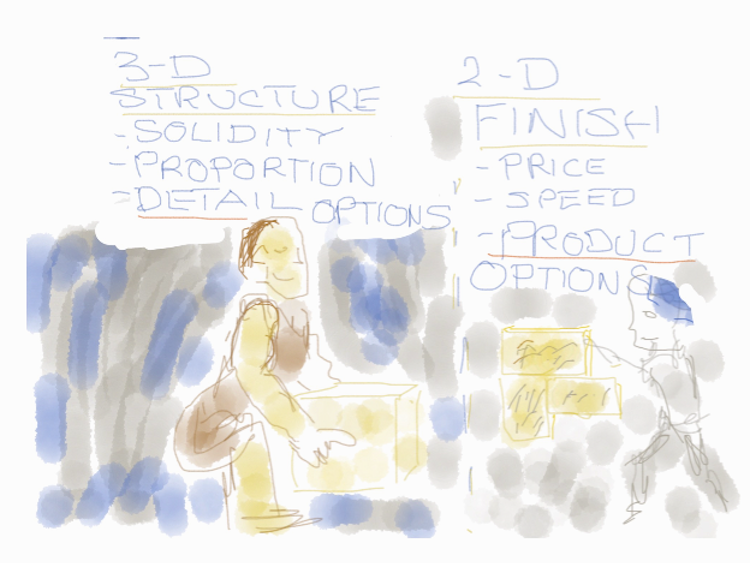
Stone structure is most vividly expressed at the architectural ‘edges’, Corners, Copings, Jambs, Lintels, Arches and Stair Treads.
The third dimension afforded by Solid Block Stock adds another dimension (literally) to detail options.
Characteristics of Structurally Expressive Stone Elements
– Local Sourcing
The larger and therefore heavier dimensions of certain detail pieces in this model make ocean travel more expensive per m2 of facade product. So stone choices here tend to be sourced closer to home.
– Detail Dexterity
Again the larger, solid details employed here mean that the 5 key areas of structural dimension may be crafted with greater freedom and are therefore more able to comply with the demands of balanced proportion and gauging.
To exemplify, a sculptor has greater 3-Dimensional freedom with a stone block than a stone tile. Similarly, the designer and the stone craftsman may express themselves more eloquently and harmoniously with the surrounding elements when they have ‘one more dimension’ in play.
Craft Dexterity enhancing Architectural Eloquence
One of the core foundations that architecture is built upon is ‘proportion’.
Some ‘structuralists’ argue that factory processes limit dimensional options, thus rendering architectural control of element proportion to external influences.
Dimensional Dexterity allows the possibility of ‘nuance’ and increased architectural eloquence.
By analogy, a wider vocabulary makes for richer narrative. A greater variety of notes makes for more engaging music.
– Detail, not Product Focused
The Structural Expressive model emphasises a bespoke crafted detail, rather than purchased product.
A Structural Challenge to the Perceived Cost Assumption
Because thin dimensions of stone are often less expensive to buy and build, it is assumed that all Finish options will cost less than Structurally expressive ones.
Finish options generally do cost less than Structurally expressive ones.
However there are counterpoints.
Where stone elements are structural they may supersede the need for hidden structure. This results in a cost saving on structure.
This saving may be significant in the scenario of single span stone stair treads, for example.
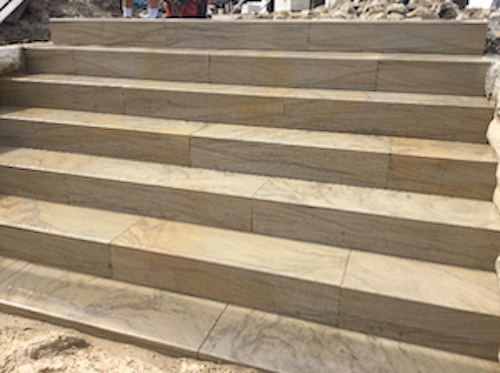 Structural Stair Treads reduce the need for (and cost of) concrete support structure
Structural Stair Treads reduce the need for (and cost of) concrete support structure
There may also be an equity loss, especially in traditional contexts where ‘economical’ finishes erode the elegance and equity strength of the traditional craft embedded in existing elements.
Finally, there is the issue of the delivering below the demand threshold. Nothing is more expensive than a client paying good money for something beneath what they really want.
Key Differences between the Structural Expression and Finish Models
The two models described thus far are not directly comparable because they each come to architecture from different directions.
Structural Expressive details come from history.
Their priority is 3-D Detail dexterity.
Stone finish products come from a cutting factory, but notionally, they may have been conceptualised from an Interior Design culture.
Their priority is 2-D Surface beauty.
Is there a third way?
A Hybrid Model
There may be a Third Way- to deliver benefits from both models, whilst resolving details with ideal aesthetics.
With some imagination on the part of suppliers, designers and craft persons, a Hybrid system of detailing may be possible, where ideal structurally expressive stone details may be inter-woven with the economies of a Stone as Finish model.
A structurally expressive effect may be created by appropriately dimensioning key elements:
- Quoin (the supply market has already made some progress here)
- Lintel
- Coping
- Jamb
- Sill
- Tread
In this scenario, the ‘areas between’ these edge details are treated as ‘Stone as Finish’, thus allowing the economy and the prevailing culture of Structure/Finish installation to continue productively.
The key aspect of the Hybrid model is that stone does not pretend to be structural at these key edges. It IS structural.
The design challenge, and it requires attendance at the engineering phase, is the interface between stone and concrete (or other masonry) in the role of structure.
Some early inroads have been made in this area of Hybrid Stone/ Structure detailing, but more could be done to make this option accessible to the market.
At the set out phase, (such as the corners) stone is the structure.
Then the structural role is passed to the ‘hidden’ structure section (usually the Wall areas between corners, and below Copings).
Here the economy of the Finish applied to Structure model may make budget and schedule gains. (This information is available but not in this report)
Comparing Models and Assumptions – a Summary
Under the Stone as Finish model, the Finish supply market serves the first two aspects of detail, (Selection and Texture), with a massive spectrum of Product choice, choice defined by stone type, colour and texture.
Within the Structural Expression model, all 5 Detailing Criteria are perceived as an opportunity to express Detail architecturally.
So whilst the ‘Finish model’ offers a vast array of Product choice, the ‘Structural Expression model’ offers a wider range of Detail choice, that is, a choice amongst articulate architectural details that take into account other criteria, such as dimension, gauging, proportion and ideal interface.
Which is the most ideal approach?
It begins with personal architectural belief.
Key Questions
If considering a stone Product within the Stone as Finish Model, key questions may be:
- Does the product range include structurally expressive Quoin, Jamb, Sill, Lintel, Coping, and Tread Details? (to the extent these elements are part of your project, and/or part of your architectural assumption)
- A stone style is only as architectural as the strength of its edge details. Are your edge details physically and architecturally strong?
- Does your chosen product create a sense of bespoke hand-craft rather than one of factory repetition?
- Are the dimensions of each stone piece of appropriate proportion to suit the architectural intentions of the walls, Paths, openings, and stairs, and that of your overarching design metaphor? (Crucial here often is the three dimensions expressed in the Coping Detail).
If considering a Structural Expressive or Hybrid Model key considerations are:
- Have your structurally expressive stone details been considered at the structural design phase?
- If so, has the structure been built to respect that consideration? (Special attention is needed here at corners, Wall heights, and in the gauging of stair structures.)
- Has your budget made allowance for the larger dimensions and the higher craft component involved in structural edge details?
- Have all opportunities for the economising of non-expressive elements been considered?’
Conclusion
Choices about stone run deeper than the concepts of ‘finish’ or ‘product’ and reach into the possibility of architectural compromise.
The choice of stone detail is may also be a choice of stone design model.
Stone choices begin with a fundamental question:
Is stone an opportunity for a fully expressive, architectural detail?
Or, is it a structurally-neutral geological exhibit?
‘God is in the detail’
Ludwig Mies van der Rohe
Damian Cudmore studied architecture and construction at NSWIT in the late seventies.
After turning his attention to masonry, he has been cutting, crafting, and now designing with sandstone.
His design practice ‘true stone design’ works to advance sandstone aesthetics, and to advocate for structurally-expressive stone detailing, from traditional to modern forms, including the hybrid model described above.
Damian has no commercial interest with any quarry or stone supplier, and welcomes conversation with anyone looking to optimise stone detailing: damian@truestonedesign.com.au
Glossary of Terms
Emotional Aesthetics (aka inner beauty)
This is the notion that an element has not only a ‘look’, but also a ‘feel’.
Is a detail attractive because of how it physically ‘looks’ or how it ‘feels’ in the space, because it ‘feels’ ‘fresh’, or ‘old’, or ‘primal’?
Do the dimensions of the chosen stone satisfy the overall metaphor and design brief?
Does a stone surface finish ultimately satisfy the design intention?
Is stone even necessary or desirable if it is likely to make trivial contribution to the overall metaphor?
For instance, painted brick may express architectural intentions more adequately, for even less cost than stone tiles.
Sometimes a crusty old brick might satisfy all criteria.
Criteria to consider in the Detailing of Architectural Stone
There are 5 key aspects of detail possibility offered by architectural stone. These are:
- Selection- (Colour Tone Strength Salt resistance)
- Texture
- Gauging and Proportion
- Structural Expression
- Relationship with Interface Elements
Exterior Design
This is that area of design that concerns itself with the external envelope of buildings, as well as that of garden areas and structural landscape.
Given the modern culture of designing Indoor/Outdoor spaces, it could also include Covered BBQ areas, and Fireplaces in open plan Living areas.
Hybrid Structural Expression
In this model the role of structure is shared by both the Hidden Structure, and by selected structurally expressive stone elements, notably quoins, Copings, Lintels, Jambs, Sills and Treads.
Mark of the Hand Concept
Signs of hand craft offer a unique attraction to many users of space. Structurally expressive elements crafted in bespoke workshops often offer opportunity to finish surfaces by hand.
Material Strength
A material may be strong in tension, such as timber or steel.
And it may be strong in compression, such as brick and stone.
Modern reinforced concrete, when designed and crafted correctly is strong in both.
Mitre
The practice of cutting a material at an angle, often used to create a stone Corner Detail.
Painter and Decorator Lineage
The recent rise of CAD with its inherent separation of ‘material’ and ‘surface’ and the Designer Sector, which may be a development from the earlier Painter and Decorator culture, is highly competent in surface colour, tone and texture – in 2 dimensions.
Expanded outward from the ‘private’, interior elements, TCTT stone detailing has moved from bathrooms and kitchens out to the lounge room feature walls, and then verandahs, and finally the outdoor proper, including landscape walls and stairs and, most recently, building facades.
Its influence has moved from interior, private space to exterior space.
Possible Future Directions for the Stone Supply Market
– Structurally expressive product options
– Three dimensional blocks offered unfinished alongside finished products
– Hybrid Detail Products
To be fair to stone suppliers, there may not be many demanding Structurally Expressive Product Options as described here, but if suppliers do find demand for this in the future there are options they could consider.
For example, developments in wire-saw technology may allow the production of 3-Dimensional Coping Product (U), Long L-Quoin, Long End Quoin (U), L-Jamb, L- Tread, L-Lintel.
Quoins
These are commonly known as Cornerstones.
They are by definition three dimensional.
Depending on their particular shape and proportion, they will contribute to structural expression to varying degrees.
Short-Quoin
The practice of economising on a Quoin Detail to the point that appropriate proportion and structural expression is diminished.
Solid Block Stock
A solid stone supply option offered by some suppliers.
These three-dimensional pieces allow structurally expressive details to be crafted.
Structural Expression
5 Elements of Stone Detailing – way beyond Type, Colour and Tone the key aspects of stone detail are:
- Selection (which includes type, colour and tone)
- Texture
- Gauging and Proportion
- Relationship with Interface Elements
- Interface with Adjoining elements
And STRUCTURAL EXPRESSION.
TCTT Assumption
This is an assumption that a stone product choice is 2-Dimensional only, and need only consider:
- Type (limestone, marble, sandstone etc)
- Colour
- Tone
- Texture
Two Dimensional Diversity
The finish stone supply market offers a large spectrum of stone choices, with respect to descriptors such as geological class (Igneous, Sedimentary or Metamorphic), types (ie Sandstone, granite, limestone, schist, slate, marble), colour, tone and texture.

